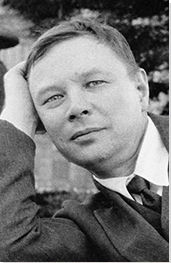Summary of Mikhail Larionov
The groundbreaking work of Mikhail Larionov helped to bring the Russian avant-garde to new prominence in the first decades of the twentieth century. With work rooted in such disparate arenas as folk art, icons, prints, modern science, and optics, Larionov, along with his lifelong partner, Natalia Goncharova, was responsible for introducing not only the first non-objective painting style in Russia, but also a new distinctly Russian style of painting that eschewed Western influence in favor of models based in Russian history and experience. With wit, determination, and an early penchant for iconoclasm, Larionov sought to pull the backward-looking Russia, still steeped in traditional peasant arts and the mysticism of the Orthodox religion, into the realm of modern art. Like Kazimir Malevich, he made use of and transformed these seemingly naïve native traditions in order to create a new and radical art for Russia.
Accomplishments
- Larionov was an important conduit between Russian artists and modern art in France. He helped organize the first significant exhibition of French Post-Impressionist and Fauvist painting in Moscow, and as a founding member of the Jack of Diamonds group, he advocated for an ongoing dialogue with artistic developments in the West.
- Seeking to set aside Western influence in favor of a new, distinctly Russian painting style based in native art and folk traditions, Larionov and his partner Natalia Goncharova initiated a new movement called Neo-Primitivism. Favoring garish colors, radical distortions, and everyday subjects, Neo-Primitivist paintings looked to icons and the colorful stylized woodblock prints known as lubki. This preference Russian precedents differentiated Russian Futurism from other pre-war avant-garde movements that looked to the "primitive art" of other cultures.
- Through his study of optics and the idea that art should depict the intersections of rays of light from objects, Larionov and Goncharova established the first nonobjective painting style in Russia called luchizm (variously translated in English as Rayonism or Rayism). Seeking to express dynamism and motion, Rayonism was an influential subset of Russian Futurism. It merged science and metaphysics - the X-ray and the Fourth Dimension - with his theoretical and artistic work to create a new, distinctly Russian, modern art.
- Beginning with their work for Sergei Diaghilev's Ballets Russes, Larionov and Goncharova brought a distinctive avant-garde sensibility to their set and costume designs for prominent ballet and theater productions. In so doing, they helped extend the reach and influence of Russian Futurism.
Important Art by Mikhail Larionov
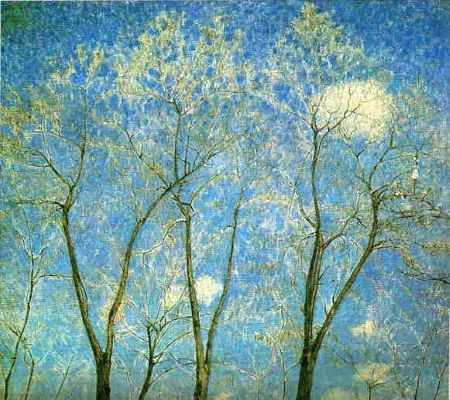
Acacias in Spring
This early work by Larionov shows a cluster of acacia trees isolated against a bright blue sky and puffy white clouds. Looking upward, the dark green tree trunks soar up, filling the canvas with their boughs. The sky is rendered in speckled azure and cornflower to suggest a clear and fresh day, while small clouds pass lightly through. The painting, which reveals the artist's close observation of nature, was inspired by Russian Post-Impressionist Igor Grabar. According to Anthony Parton, leading Larionov scholar, "The unusual viewpoint and use of boughs and branches form a skeletal structure within which to display the dappled effects of foliage and sky recall Grabar's painting February Azure of 1904."
Painted while Larionov was still a student at the Moscow College of Painting, Sculpture and Architecture, during his "Impressionist" period (1902-1906), this work, and others from this period, earned him the name "the finest Russian Impressionist." Influenced by Vincent Van Gogh, Claude Monet, Édouard Vuillard, and Pierre Bonnard, Larionov was a keen observer and he often worked outside - en plein air. Although he had moved to Moscow in 1891 to attend school, he returned often to Tiraspol, where he could paint in the garden of his grandparents' home, using an old wooden door as an easel. Acacias in Spring was one of a number of similar canvases painted in this manner, along with Rose Bush after the Rain (1904) and Flowering Acacias (1906). The works were lauded by renowned Russian critic Nikolay Punin, who dubbed Larionov's impressionist works as an important contribution to the development of Russian modernism.
Oil on canvas - The State Russian Museum, St. Petersburg
Pears
In this 1908 still life painting, a selection of pears have been placed haphazardly on a dark wooden tabletop, resting on a brightly colored cloth in pink and white and set against a green decorative background with a bold leaf pattern. Here, Larionov's use of bold colors, his flattening of the picture plane, and preference for decorative patterning, reveal the influence of modern French painting in the wake of his 1906 visit to Paris to attend (and participate in) the Salon d'Automne. In his still life paintings from this period he has synthesized aspects of Fauvism, Symbolism, and the still lifes of Post-Impressionist Paul Cézanne, which led to Larionov establishing a name for himself as the "Russian Cézanne." As Anthony Parton has noted, "Pears...recalls the flattened forms, lack of recession, perspectival distortion, and interest in modelling through tonal gradation that are found in Cézanne's later works." The use of decorative patterning and bold colors is also reminiscent of Henri Matisse, Vincent Van Gogh, and Paul Gauguin. Art historian Yevgenia Ilyukhina has said that in still lifes such as this, "Larionov engages in what might be called a dialogue with the French masters, sometimes even competing with them...His still-lifes are always full of motion...[they] seem to demand a new generic term: neither 'still life' nor 'quiet life of objects' is appropriate."
Pears was painted the same year as the first Golden Fleece exhibition in Moscow, which Larionov helped organize with Nikolay Ryabushinsky. Ryabushinsky, editor of Golden Fleece, a symbolist magazine dedicated to art and literature, was influential in the Russian art world and later became Larionov's patron. The Golden Fleece exhibition was an important touchstone in the history of modern art in Russia, as it featured important works by modern French painters alongside the work of Russian artists. It proved particularly influential for Larionov who was seeking to create his own painting style that synthesized Russian and French painting traditions.
Oil on canvas - The State Russian Museum, St. Petersburg
A Stroll in a Provincial Town
In A Stroll in a Provincial Town, a group of crudely painted figures, almost caricatures, appear to walk along a street, while a waiter attends to a table at a café. Devoid of modeling or any attempt at geometric perspective, the figures appear to float across the painting's surface, hovering above the wide swath of grey paint that approximates a city street. The emphasis here on the horizontal is reminiscent of cartoon strips, which, as art historian Camilla Gray has noted, "produce[s] an effect of child-like indifference to conventional rules." Still borrowing themes and compositional strategies from French painting in his preference for dandy-like figures and social settings, Gray suggests that this and other paintings from this period are less concerned with creating a coherent scene than they are with developing a "caricature of a social scene [by] reducing it to a series of private, unrelated actions."
Among the first of Larionov's primitivist works, A Stroll in a Provincial Town reveals the continued, but diminishing influence of French painting, and his newfound interest in specifically Russian artistic sources, including folk art and Russian genre painting. In this work, the characters are depicted as flat, two dimensional shapes (similar to cut-outs) that are delineated with thick, dark outlines, in the style of Russian lubki. Popular since the 18th century, lubok prints, or lubki, were elaborately colored woodcuts or engravings with simple, flat designs that were originally religious in subject, but later incorporated social or political messages. Having worked through various modes of French painting from Post-Impressionism to Symbolism and the Fauves, he has begun to turn his gaze inward to native Russian traditions in an effort to establish a new Russian avant-garde.
Oil on canvas - State Tretyakov Gallery, Moscow
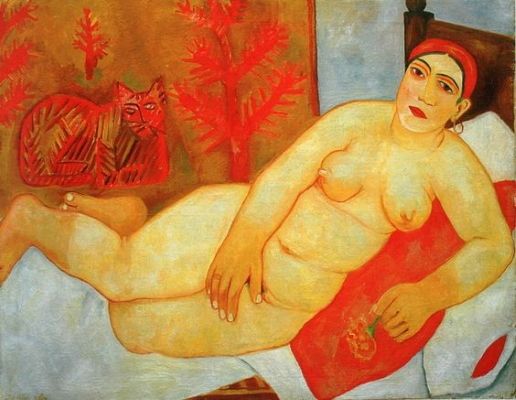
Katsap Venus
In this 1912 painting by Mikhail Larionov, a reclining woman, in the guise of Venus, has turned toward the viewer as she places a concealing hand across her lap. Clearly influenced by Manet's Olympia (1863-65), the Katsap Venus reverses Olympia's pose, and the requisite cat appears on an embroidered tapestry rather than at her feet. The maid is absent, and the flower has moved from behind the Venus' ear to her hand. While both works emphasize the flatness of the picture plane, particularly in rendering the bodies, the Katsap Venus is depicted with a heft and bulk that is absent from Manet's Olympia. In Larionov's Venus, the scarf and earrings are ethnic markers, used to identify her heritage and the yellow tone of the skin indicates her status as a working prostitute (in Russia prostitutes were required by law to carry a yellow card). The primitivist style - the flatness of the image, lack of modeling, use of vibrant colors, and the influence of signage and peasant embroidery - speak to Larionov's evolving relationship with European and Russian artistic models. Although the Katsap Venus is part of a larger effort by Larionov to re-appropriate antiquity, it is, according to art historian Sarah Warren, "clearly an antiquity mediated by modernism," as demonstrated through its clear reference to Manet.
Also known as Russian Venus, the Katsap Venus is one of a series of ethnic Venus paintings - which included the Jewish Venus and the Gypsy Venus - that Larionov produced in 1912. The unfinished Venus series, according to a contemporary account by Larionov, was also to include Turkish, Greek, Chinese, Japanese, Indian, Black, Ukranian, and French Venuses, each of which would be identifiable by "characteristic features" as a celebration of ethnic diversity. A newspaper article published at the time stated that Larionov's three Venuses were produced as an exploration of ethnological canons of beauty. Larionov scholar Anthony Parton has argued that the Russian [Katsap] Venus is, in fact, an army prostitute. ("Katsap" was a derogatory Ukrainian term for Russians and is used to describe a Ukrainian prostitute who services Russian soldiers.) Parton adds: "The theme of carnal love, symbolized by the army prostitute, was a crucial aspect of Larionov's neo-primitive ideology. It referred to instinctive feelings, represented a shocking subject for his audience, but above all, in the tradition of Manet, replaced the academic image of Venus with that of a specific type of woman in contemporary society - an early and tangible goddess of love."
Oil on canvas - Nizhny-Novgorod, State Museum of Art
Spring. Seasons of the Year (New Primitivism)
One of four paintings representing the seasons of the year, Spring, which includes text, trees, human figures and animals, is rendered in a naive style that is almost childlike in its simplification of forms. Working in a Neo-Primitive style, which Larionov used to subvert the "Western" fine art tradition, the Seasons of the Year were inspired by the artist's interest in various native and primitive art forms that are combined with references to pagan and classical deities. Divided into four quadrants, Spring is awash with vibrant gold and yellow that serves as a background for a series of images and text that appear to float on the painting's surface. The radically simplified forms are seemingly unconnected to one another. In the top left quadrant, two putti appear to be helping the female figure to fly, while a crudely painted bird extends a flowering branch. In the left quadrant we see lines of Russian text and at the top right, a flowering tree with caterpillar and butterfly beneath. The painting's seemingly disparate elements pay tribute to the artist's heritage, and, as Anthony Parton has noted, "reinvigorate painting by returning to the stylistic principles of native Russian art forms and the pictorial conventions of naive artists and peasant craftspeople." In addition to these native Russian painting traditions, Larionov also references children's drawing, representing the seasons with naïvely painted elements that are situated within rigid right angles, which, according to art historian G. G. Pospelov, are reminiscent of children's notebooks.
The four Seasons of the Year paintings marked a turning point in Larionov's work and the end of his Neo-Primitive style. Having rejected Western painting styles in favor of Russian models, the Seasons came on the heels of his abrupt departure from the Jack of Diamonds group due to their continued allegiance to modern French and German art. Painted in 1912, the same year he founded Donkey's Tail, Spring was an important example of Larionov's synthesis of various Russian and Eastern styles and traditions. It was shown in the group's first exhibition, called the "Target," in Moscow in 1913. As an attempt to address the indigenous cultural traditions of Russian art in the face of academic and modernist traditions imported from the West, the painting, and the exhibition it was included in, were intended as a provocation to audiences still looking to the West. The radical simplification of forms seen in the Seasons paintings paved the way for his Rayonist compositions of the following year.
Oil on canvas - The Tretyakov Gallery
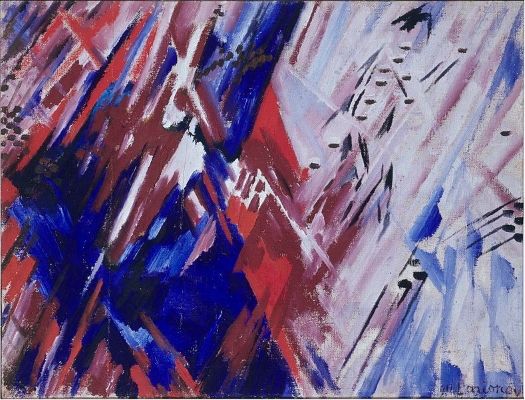
Sea Beach and Woman (Pneumo-Rayonism)
In this 1913 non-objective painting, Larionov has wholly embraced abstraction, using intersecting diagonal slashes of blue, red, and white paint to create a sense of energetic dynamism that bears little resemblance to the painting's title. An example of Larionov's Rayonist paintings, a style he developed with Goncharova, Sea Beach and Woman gives visual form to his newly elaborated Rayonist theory. Informed by his interest in optics, radiation, X-rays, and the Fourth Dimension, the artists sought to depict the dynamic intersection of rays of light. He later described Rayonism as the painting of "intangible forms and immaterial objects" in space. The term Rayonism comes from a literal translation of "luchizm," luch meaning ray in Russian. (It is also sometimes called Rayonism.) As Anthony Parton has said: "Larionov's rayism...was an abstract and nonobjective style of painting. The first Rayonist canvases depict rays of light reflected from everyday objects which shatter the picture space, while subsequent works represent only the rays themselves which intersect to create dynamic planes of color."
Despite its relative importance to later Russian art, Rayonism attracted few followers. Larionov was nevertheless eager to explore the various aspects of this new work, expounding on his ideas in four manifestos. This theoretical work fascinated the avant-garde at the time. He wrote: "Hail to our rayonnist style of painting independent of real forms, existing and developing according to the laws of painting. (Rayonism is a synthesis of Cubism, Futurism and Orphism.) . . . The style of Rayonist painting promoted by us is concerned with spatial forms which are obtained through the crossing of reflected rays from various objects, and forms which are singled out by the artist." Rayonism was thus a synthesis of ideas gleaned from the international avant-garde and native Russian art and folk culture, but also from his interests in science and the Fourth Dimension. Importantly, Larionov's shift to non-objectivity allowed him to focus on color, shape, and the texture of the paint of the canvas, rather than on subject matter or symbolism. This new focus on painting's essential elements proved influential for the future of Russian art, including Suprematism and Constructivism.
Oil on canvas - Museum Ludwig, Cologne, Germany
Biography of Mikhail Larionov
Childhood
Mikhail Larionov was born into a Russian Orthodox family in Tiraspol, Russia, in 1881, in the home of his mother's parents. His father, Fedor Michailovich Larionov, was a doctor and pharmacist at the Tiraspol Military Hospital, and his mother, Aleksandra Fedorovna Petrovskaya was a farmer's daughter.
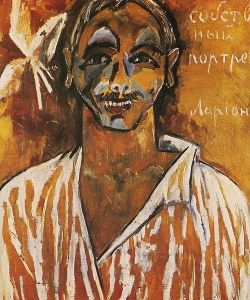
He lived a happy childhood in Tiraspol, where he enjoyed exploring the town and the lush landscape with its sprawling meadows and gardens. He would return to the province throughout his adult life to find inspiration for his painting.
His family moved to Moscow in 1891, where, at the age of twelve, he began his secondary education at the Voskrensky Technical High School in Moscow, graduating with a diploma two years later. In 1898, he went on to study at the Moscow School of Painting, Sculpture and Architecture, where he worked under the landscapist Isaac Levitan. At the art school in 1900, he met fellow student Natalia Sergeevna Goncharova, who proved to be an important early influence on the young artist. The two would form a personal and professional partnership that would last until Goncharova's death in 1962. As Goncharova would later say, "since me and Larionov once met, we've never parted." The couple's parents were not pleased with the relationship, but the young couple moved into an apartment in Moscow nevertheless, where they lived and worked together.
Training and Early Work
Larionov had his first exhibition in 1902 and went on to train under Vasily Baksheev, Valentin Serov and Konstantin Korovin at the Moscow School of Painting, Sculpture and Architecture. It was around this time that the young artist's behavior became disruptive and he started causing problems at the school. In one instance, he took up all the available wall space at the Moscow school by hanging 150 of his paintings, leaving no room for the work of other students. It has been suggested that the director of the school told him to remove his work, and when he refused, he was expelled. (This story has never been proven and Anthony Parton, a leading Larionov scholar, claims it is apocryphal. The school's archives suggest that he was asked to leave for failing to complete his work.) Nevertheless, Larionov soon gained a reputation as a troublemaker bent on shaking up the establishment. During the remainder of his studies, he was expelled from the school two more times. Although he was reinstated at the Moscow School, he was expelled with a second class diploma in 1910 for leading a student demonstration. As he said around this time: "All that has become established in art depresses me...I sense stagnation and it suffocates me... I want to escape from these walls to a boundless space, to find myself in constant motion..."
As fate would have it, he met Sergei Diaghilev, the Russian art critic, patron and founder of the Ballets Russes, in 1903 at a Moscow exhibition. The two formed a close professional relationship that would continue into the late 1920s.
By 1906, Larionov was gaining recognition for his paintings from critics and collectors and he began exhibiting his work in earnest. That year he was invited to show with the Union of Russian Artists, and in Paris, he was invited to participate in the Russian art exhibition at the Salon d'Automne. While in Paris he was introduced to the work of Paul Gauguin, Paul Cézanne, and the Fauves, and quickly fell under the spell of French modernism. The following years were the most prolific of Larionov's life, as he embarked on a frenzy of painting, literature, film, cabaret, performance, and the organization of multiple exhibitions. Although critical reception of his work was mixed, he exhibited frequently. During this time he befriended other members of the Russian avant-garde, including Wassily Kandinsky, Kazimir Malevich and Georgy Yakulov.
In 1910, he was a founder member of the Jack of Diamonds group (Bubnovyi valet, 1910-1917) which advocated an alternative exhibition society for young artists eager to break free from artistic tradition. However, relations with other members became frayed and in 1911 he broke from the group and formed a new collective with Goncharova; the Donkey's Tail (Oslinyi Khvost, 1911-1915). Within the context of the new group, Larionov and Goncharova advocated for the creation of a new Russian contemporary art that drew less on European art and instead looked to Russian artistic traditions. (The group's name, The Donkey's Tail, referred to a famous hoax in which art critic Roland Dorgelès and friend Frédéric Gérard tied a paintbrush to a donkey's tail to produce a painting that was then exhibited, without explanation, at the 1905 Salon des Indépendents.) The group included Marc Chagall, Kazimir Malevich, and Aleksandr Shevchenko. Their first exhibition was met with controversy when the Public Censor, who objected to the display of paintings with religious subject matter under a title that included the word "tail," told the police to confiscate several of Goncharova's paintings. Goncharova herself was a provocative figure and in 1910 she was put on trial for pornography for nude life studies in one of her exhibitions. She was later acquitted.
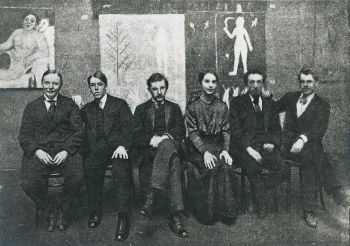
In 1912, inspired by Filippo Tommaso Marinetti's lectures on Futurism, Larionov began his first explorations into Rayonism (sometimes termed Rayism); a groundbreaking new movement that synthesized Cubism, Futurism, and Orphism. Larionov claimed to have painted his first Rayonist painting in 1909, but he was not always accurate with his paintings' chronology. He would often omit the date on his paintings or backdate his canvases after the fact, sometimes by more than a decade. As Anthony Parton has noted: "Inaccurate memory undoubtedly played its part, but Larionov was a shrewd propagandist of [his and Goncharova's] historic role as painters."
At around the same time, Larionov and Goncharova began to explore Neo-Primitivism, which, taking from traditional Russian Lubok prints, icons, and peasant arts and crafts, consolidated the ideas put forward by Donkey's Tail group. Namely, that the new art should look to popular Russian art forms and focus on everyday subjects The following year the Jack of Diamonds and the Donkey's Tail groups reconciled their differences and began to collaborate on exhibitions.
Their varied activities from these years - avant-garde art production, theater and performance, literature and poetry - can be categorized under the larger rubric of Russian Futurism, which dominated the Russian avant-garde between 1910 and 1916. Neo-Primitivism and Rayonism were particularly important for the history of modern Russian art in the years leading up to and following the Russian Revolution in 1917.
Mature Period
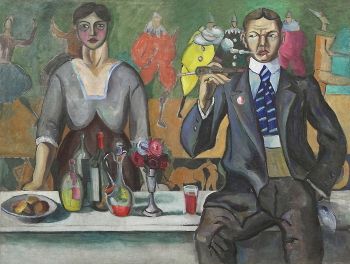
By 1913 Larionov found greater independence and began to break away from the groups he had previously worked with, preferring instead to consider himself one of the "futurepeople." He wrote at the time: "We, Rayonists and Futurepeople, don't wish to speak about new or old art, and even less about contemporary Western art...We acknowledge all styles as suitable for the expression of our creativity, those existing both yesterday and today such as cubism, futurism and their synthesis rayonism." This crystalized the concept of "everythingism", which meant that all styles from all periods were accepted.
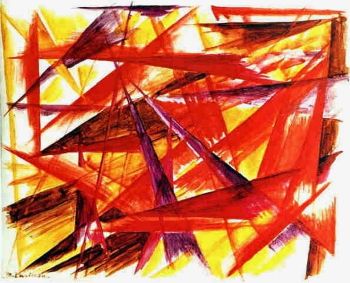
The same year he became involved in set design, producing sets for Bolshakov's play Plyaska ulits, a dynamic spectacle in which the actors, floor, and stage were in constant movement. The play was a form of "Futurist Theatre," which rejected accepted theatrical conventions in favor of aggressive improvisation. Larionov and Goncharova also organized Futurist evenings, during which they would paint their faces with Rayonist designs and entertain and abuse the crowds. On one such evening Larionov called the audience "jack-asses" and "boors". As the poet Mayakovsky wrote: "The feeling... ran so high that if the police had not intervened, everything would have ended in a bloody battle." The venue was later shut down.
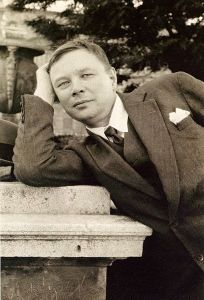
During this period Larionov also explored fashion design, even publishing an outrageous manifesto stating that men should wear sandals with painted feet, shave off half their facial hair and plait yellow tassels in their hair. Women meanwhile were told to go topless with painted breasts.
The two had successfully whipped up a storm of publicity which was compounded with scandalous stories in the press and risqué media interviews. The following year they left Moscow for Paris, where they worked on the set design for Sergei Diaghilev's ballet Le Coq d'Or. They moved to 65 Boulevard Arago and became friends with the poet Guillaume Apollinaire, who in turn introduced them to the French avant-garde. Their first exhibition in Paris was attended by the glitterati of the day; Coco Chanel, Pavlova, Max Jacob, Robert Delaunay, Jean Cocteau, Constantin Brâncuși, Georges Braque, André Derain and Pablo Picasso, among others.
Late Period
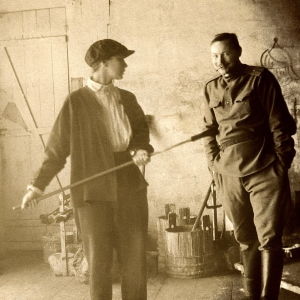
The couple's ascent into international stardom was interrupted when Larionov was called to fight for the Russian Army with the start of World War I. In August 1914 he was mobilized as an adjutant-chief in 210th Bronnitsky Infantry Regiment. He was sent to fight in the Prussian invasion and was wounded in October, when he was concussed by an exploding shell and developed a kidney infection. He spent three months in the hospital before he was medically discharged in 1915. He returned to Russia to convalesce, but he never fully recovered his creative energy. As his friend, artist Serge Fotinsky, later wrote: "Because of his injury he lost the determination and persistency that a creative person has to have...He couldn't concentrate...He couldn't stay still, he went to bed at four o'clock in the morning and slept until two or three in the afternoon...Deep down he was not at peace, there was something gnawing at him, a kind of anxiety..."
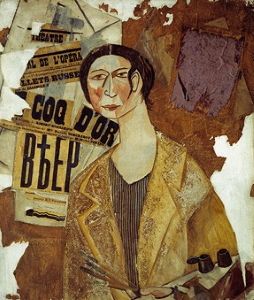
The following year, Larionov and Goncharova left for Switzerland to join their friends Diaghilev and the composer Stravinsky to work on costume and set design. They spent much of the next few years traveling throughout France, Spain, Italy, England, and the United States. In London, they befriended the influential art critic Roger Fry, who wrote favorably about their work and promoted their designs for one of Diaghilev's ballets.
In 1919 the couple returned to Paris and immersed themselves once again in Parisian café culture, reigniting many of their friendships with the French avant-garde. Although they were happy to be back in Paris, Larionov's painting decreased significantly; some blamed his poor health, while others blamed laziness. That same year his brother died in Russia fighting in the Red Army.
Throughout the 1920s Larionov continued his work with Diaghilev and the Ballets Russes, which ceased in 1929 with Diaghilev's death. In the years that followed Larionov returned to painting and the couple began to work with other ballets and operas in Paris. They stayed in Paris, even after the deaths of several close friends, including Léon Bakst, Guillaume Apollinaire and Juan Gris. They could not return to Stalinist Russia, where purges were in full force and the avant-garde were considered enemies of the state. When Hitler invaded Austria in 1938, they realized they could never go home. They applied for French citizenship that year and remained in France throughout the war. During a trip to London in 1950 Larionov suffered a stroke. He was taken back to France to recuperate but his left arm was paralyzed, along with the right side of his face After the stroke Larionov ceased creative activities altogether. The couple finally married in 1955, which meant that they could inherit one another's work if one of them should die. By this point Larionov's illness had taken its toll on both of them, and a friend remarked that Goncharova was "wasting away". She was diagnosed with terminal cancer and died in 1962.
Unable to cope alone, Larionov invited Alexandra Tomilina to move into his Paris home to help him. She became his secretary and guardian; they married the following year. In 1964 Larionov died at the age of 82. He was buried next to Goncharova in Ivry Cemetery, Paris.
The Legacy of Mikhail Larionov
A key figure in the Russian avant-garde in the years leading up to World War One, Larionov was, as art historian Andréi Nakov has noted: "A highly talented painter with an outstanding imagination...Larionov appeared like a meteor in the history of Russian painting." Thanks to the efforts of Larionov and Goncharova Russian Futurism was more than just a literary movement; it was also an important and influential movement in the visual arts.
Often described as a "forefather of abstract art," Larionov took from Italian Futurism to create a new abstract style known as Rayonism, which laid the groundwork for Constructivism. As Anthony Parton explained: "In stylistic terms, the influence of Larionov's Rayonism can be traced in the post-revolutionary work of several constructivist artists, including Lyubov Popova and Alexander Rodchenko." His reimagining of folk art and use of Neo-Primitivism can also be seen in mystical and naive style of Russian-French artist Marc Chagall, who is thought to be influenced by Larionov.
In 1979, thanks to the hard work of Alexandra Larionova-Tomilina, Larionov's second wife, the Russian Museum and Tretyakov Gallery organized an exhibition which for the first time featured Larionov's works from both Russian and French collections in the same space. And although the couple could never return to Russia, in 1989 their combined works were at last collected and hung in the Tretyakov Gallery, which also stored their vast archive and library.
Influences and Connections

-
![Niko Pirosmani]() Niko Pirosmani
Niko Pirosmani - Viktor Borisov-Mustatov
- Vasily Baksheev
- Valentin Serov
- Isaak Levitan
-
![Rayonism]() Rayonism
Rayonism -
![Constructivism]() Constructivism
Constructivism -
![Suprematism]() Suprematism
Suprematism ![Neo-Primitivism]() Neo-Primitivism
Neo-Primitivism
Useful Resources on Mikhail Larionov
- A Guide to Russian Art of the 20th centuryBy by Sergey Yepikhin and others
- Goncharova/Larionov: Works on Paper by Natalis Goncharova and Mikhail LarionovBy Jane A Sharp
- ManifestesBy Mikhail Larionov
- Mikhail Larionov (1881-1964)By by Evgeni Kovtun
- Mikhail Larionov and the Russian Avant-gardeOur PickBy Anthony Parton
- Mikhail Larionov and the Cultural Politics of Late Imperial RussiaBy Sarah Warren
 Ask The Art Story AI
Ask The Art Story AI